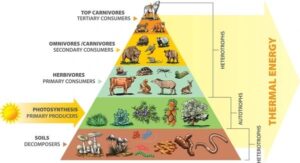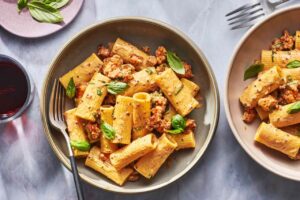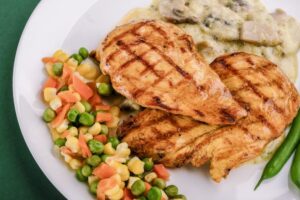What is a food chain?

A food chain refers to an ecological process in which living things consume each other before being devoured by larger organisms. Energy and nutrients flow across species at various trophic levels in an ecosystem in a manner known as a “feedback loop.”. Trophic levels refer to various stages in this chain, beginning from producers at its base up to primary, secondary, and third consumers; each stage is known as a trophic stage in this food chain. A food chain comprises several main parts. Producers are autotrophs like phytoplankton, cyanobacteria, algae, and green plants that generate food through photosynthesis using solar energy for fuel. These producers form their foundation by using sunlight’s power to make food from nothing! Producers may include any organism, plant, or animal that utilizes photosynthesis for its sustenance needs, with organisms being autotrophs due to producing what they consume via photosynthesis being considered producers in general terms. Consumers refer to organisms that rely on other living organisms or plants for sustenance. A food web comprises almost all living creatures, as consumers rely heavily on each other as food sources. Consumers include herbivores that consume plants, carnivores who feed on other species for sustenance, parasites who inhabit certain organisms to harm them, and parasites who reside on certain individuals to harm them, as well as scavengers who consume decomposing carcasses after creatures have passed on, plus scavengers who consume deceased animal carcasses from consumption by other consumers—an integral component of any food web! Herbivores in this case can be considered primary consumers, while carnivores represent second-tier consumers. Both species inhabiting the second trophic layer consume producers. Therefore, herbivores, or primary consumers, include people residing within that second layer. Decomposers, organisms that derive strength from waste or lifeless natural material, represent the very last degree inside the meal chain. Decomposers play a necessary role in offering critical nutrients to soil by breaking down organic fabric into inorganic materials, which provide critical nourishment to soil ecosystems. Decomposers play an essential part in recycling substances they ingest by returning minerals into oceans or soil, where producers or autotrophs may utilize them in turn, starting a fresh food chain that extends across multiple food chains within an interlinked food web. Food webs resemble chains of food in that both consist of interlinked species eating each other; in some instances, an individual species might even be consumed by multiple predators or by multiple other species; this explains why so much of tropical biodiversity lies within one system. Food chains don’t accurately demonstrate energy flow. In contrast, the food web provides the right visualization as it shows interactions among species. With more interrelationships between various food chains forming their structure and becoming increasingly complicated over time,. Such complexity could ultimately contribute to an ecologically sustainable system.
Food Chain Integrity

Integrity is multifaceted when considering food supply chains from producer to consumer, from producers through all stages. Modern food chain integrity measures centre around factors including the microbiological and chemical safety of foodstuffs as well as source integrity (authenticity of source), fraud detection, and quality assessments. Sooner or later, customers will expect products to meet more stringent eco-friendly, animal welfare-oriented, no-child labor-free criteria, as well as trade with emerging nations’ standards for the production of high-integrity food. Food businesses must transform such consumer sentiments into objective standards for producing food with integrity. Detritus Food ChainThe detritus food chain includes various living organisms as well as plant species like algae, bacteria, and fungi, as well as protozoa and insect mites, among others. Decomposers begin feeding off dead organic matter; energy from food then gets converted to decomposers, which in turn become food sources for detritivores and decomposers, which later feed carnivorous organisms such as maggots, which become food for larger carnivorous organisms such as snakes, frogs, etc. Primary consumers include protozoans Fungi bacteria, among others, feed off decayed organic debris, while other consumers include protozoans Fungi feed off decayed material that feeds off debris before moving back upstream again into food chains that begin. One type of food chain known as food chain grazing begins with green plants and then moves on through herbivores before becoming carnivorous. With such an ecosystem in place, energy for photosynthesis becomes limited at the foundational levels of food chains, grazing or otherwise. At the root of it all lies the energy exchange between herbivores and autotrophs; from here, energy can travel back down through this food chain until reaching herbivores again for consumption. As autotrophs form the basis of nearly all ecosystems on Earth, most food chains worldwide follow this particular model of sustenance distribution. Such chains facilitate both local and international commerce through complex flows. Supply and exchange chains may both play an integral part. Regulations enforced by intergovernmental bodies provide structure for this market, while social input raises standards through private industry participation. As part of global trade in food chains, small farmers cannot participate in large portions of production both globally and locally. To illustrate its complexity in India, the United States is shown as a component in this chain. Humans play various roles within a food chain depending on what they consume as sustenance. If humans only eat plants as sustenance, then their role as primary consumers would be clear; otherwise, they are called secondary or omnivore consumers, respectively. Animals too are consumers in food chains since they consume both plants and other animals that consume plants in one way or another as consumers, producers make food, consumers eat it up before it finally ends with predators taking it all down through one continuous pathway into energy flow pathways of various sorts (in food chains it all starts from producers making food production to being eaten upstream of producers by producers making food production all the way up until topmost predators at last) where energy flows down one path while food webs present multiple energy flow paths between organisms eating multiple items consuming an organism consumes multiple items, unlike food chains where energy flows one way only through one path for energy flow while one way flow exists between producers producing energy flow pathways from one stage of energy flow while there can be multiple paths through which energy flows between various organisms in that particular chain or web structure where energy flow follows one path), one path than another when considering energy flow within this complex system of course.
Farm-to-Market Food Chain
A food chain refers to the complex distribution system for both locally produced food items as well as international supplies of them and serves both as supply and value chains. Many regulations imposed by international organizations act as the foundation for these markets. Social contributions also raise standards by engaging the private sector. Unfortunately, global trade within food supply chains kept small-scale farmers out of much of global production as well as local markets. To demonstrate the complexity of food chains in both India and America, different components from both chains have been displayed here. Strong top-down influence can result in cascading cascades of trophic elements within these food chains. One of the best-studied food chains can be found in mid-latitude lakes, where researchers have conducted extensive food chain analyses. Zooplankton and phytoplankton serve as key links between plants and herbivores, providing crucial food. These large zooplankton lakes remove phytoplankton from water at an extremely rapid pace, making them one of the world’s biggest herbivores. Lakes that contain only low concentrations of planktivorous fish tend to experience lower phytoplankton densities due to the large species of zooplankton that thrive at such conditions, significantly diminishing phytoplankton populations during the midsummer months and becoming clear. Planktivorous fish provide enough planktivorous to reduce zooplankton numbers in lakes that contain enough planktivores that consume it, mitigating any negative impacts from phytoplankton-zooplankton interactions in the summer months. Consequentially, water becomes opaque with phytoplankton blooms during that season, creating an “upward cascade of planktivores to phytoplankton.” Lakes with large piscivorous species like wall-eyed pike extend four links in their chain, and planktivorous fish populations decrease, freeing Zooplankton populations from predation. Knowledge of food chains is vitally important because it reveals intricate relationships within an ecosystem, how organisms rely on each other for survival, and how energy moves within this system. Understanding food chains helps reveal these complex interrelations as they illustrate energy flow within it and thus show us where resources lie in an ecosphere.
Food Network Grill Master Unleashed
]]>Top Food Nearby in the USA

When life gives you limes, flip them into a key lime pie rather than limeade. The reputable national pie of Florida, this sassy tart has won international popularity. It all started inside the Florida Keys; that is where the little limes that gave the pie its name originated. The first Key lime pie is credited to Aunt Sally, who cooked for delivery salvager William Curry, Florida’s first self-made millionaire, in the late 1800s. However, you ought food nearby to also provide credit to Florida sponge fishermen for probably developing the recipe for key lime juice, sweetened condensed milk, and egg yolks that would be “cooked” (by a chemical reaction that thickens the aggregate) at sea. We adore French fries; however, the Tater Tot is an American take on the potato theme. This is famous in faculty cafeterias nationally and at Sonic drive-ins. These commercial hash brown cylinders are one of a kind to the Ore-Ida enterprise, as you can see through the registered trademark that is regularly on them. Had you been one of the Grigg brothers who mounted Ore-Ida, you would have also desired to find a use for the leftover pieces of chopped potatoes. In 1956, they fashioned the mash into tiny toddlers, introduced a few flours and seasonings, and then sold them. After a bit over 50 years, Food Nearby in the United States consumes about 32 million kilograms of these potatoes every year. Oddly sufficient, sourdough became fed on in historic Egypt and dates back to the time of the pyramids. However, San Francisco produces the sourest variety and is the undisputed favoured in America. Since the technology of the Gold Rush, sourdough bread has been a mainstay of local delicacies, similar to Napa Valley wine. In the past, settlers and miners who survived sourdough have been referred to as “sourdoughs” and carried pouches around their necks or belts containing sourdough starter, which became more dependable than different leavening. Thankfully, that isn’t how the Boudin Bakery, which has been producing chunk-sized bread in the city by way of the Bay when you consider 1849, does it. The chef’s salad was first created in the East; however, the American chef’s use of lettuce in the West was not going to be outdone. Owner of the Brown Derby Bob Cobb, assembled a salad in 1937 while food was nearby through the refrigerator for ingredients for a meal for Sid Grauman of Grauman’s Theatre. The elements included a head of lettuce, an avocado, a few romaine, watercress, tomatoes, some bloodless chook breast, a hard-boiled egg, chives, cheese, and a few classic French dressings. The legend about the Brown Derby states, “He started out cutting.” I introduced a few pieces of crispy bacon that I took from a working chef. The salad made its way onto the menu and into Hollywood itself.
Pot Roast

Pot roast, a cherished Sunday family meal from infant boomer childhoods across the USA, holds a sentimental spot in the top 10 consolation foods in America. Without it, a whole generation would be lost. Pot roasts can be anointed with purple wine or maybe beer, protected, and cooked on the stovetop or inside the oven. They can also be made with red meat brisket, backside or top round, or chuck positioned in a deep roasting pan with potatoes, carrots, onions, and anything else your mother threw in to be infused with the beef’s simmering juices. Since James Dewar created the traditional “Golden Sponge Cake with Creamy Filling” at the Continental Baking Company in Schiller Park, Illinois, in 1930, it’s been making us smile. When bananas were in brief supply during World War II, Twinkie’s original banana cream filling was substituted with vanilla. Deep-frying them has become popularized employing the Texas State Fair as if they were not already absurdly scrumptious. Recalling lunchtime recess, their ladyfinger form (pierced three times to inject filling), and their name (stimulated with the aid of a billboard advertising Twinkle Toe Shoes) make Twinkies endearing even when they’re ruined in warm oil or ripped from their packaging. Between November 2012 and July 2013, they were momentarily removed from the shelves because of Hostess’ bankruptcy filing. Though it can seem unusual to derive such an extreme flavour from dehydrated meat, jerky is a famous high-protein snack among avenue travelers, hikers, and campers globally. It’s American delicacies organized with the same grit and spice as our favourite backwoods fare. The creation myth that attributes its origins to American Indian pemmican, an aggregate of animal fats and fireplace-cured meat, is one that we discover appealing. Meats consist of pork, turkey, chook, venison, buffalo, or even emus, yaks, and ostriches. Glazed with honey, hickory-smoked, barbecued, and peppered. Flavoured with chili, lemon pepper, teriyaki, and jalapeño. The Army is experimenting with jerky sticks which have the caffeine content of a cup of espresso due to the fact jerky is so adaptable, portable, and nutrient-dense. Whatever shape of jerky you choose, decaf, caf, strips, or shreds, get equipped to bite for a very long time. I take it you still have your tooth? Take a few vaqueros who are employed on the range and feed them with the slaughtered cattle. Include the disposable quantities of meat in the people’s profits and allow their resourcefulness to flourish. The start of a Rio Grande location culture may be in grilling skirt steak, or “Faja” in Spanish, over a campfire and wrapping it in a tortilla. It is believed that in 1969, a sure Sonny Falcon started out running fajita taco stands at outdoor activities and rodeos in Texas, which is whilst the fajita first entered popular subculture. Soon after, the dish commenced to appear on menus throughout the Lone Star State and received popularity thanks to its loved side dish of grilled onions and inexperienced pepper, % de. Just like how the banana provides nutrients. Still, props to whoever came up with the banana split sundae variant. In 1904, a banana turned into break-up food nearby and located in an extended boat dish by way of future optometrist David Strickler, who changed into experimenting with sundaes at a pharmacy soda fountain. This incident occurred in Latrobe, Pennsylvania. The story is from Wilmington, Ohio, in 1907, when Ernest Hazard, the owner of an eating place, came up with it to attract college students from a nearby university. The cut-up became famous after a Chicago Walgreens created it as their signature dessert within the 1920s. Whatever the background, Wilmington’s annual Banana Split Festival, which takes area on the second weekend in June, offers a whole lot of meals for ideas. Cornbread is a staple of Southern cooking, but it’s also the soul meals of many other cultures, which include Native American, black, and white ones, and no longer just the ones located south of the Mason-Dixon line. If you coarsely grind corn, you get grits; if you soak kernels in alkali, you get hominy, which we advise making into posole. Cornbread is made with the aid of leaving finely ground cornmeal with baking powder. Whatever its form, cornbread—whether it is New England johnnycakes, Southern hushpuppies, or corn pone—stays the quick and easy cross-to bread that maintains it on tables throughout the kingdom and has historically made Native American and pioneer moms happy. It can be baked in muffin tins or a skillet.
GORP

“The Classic Raisins and Peanuts” GORP is the power-saving desire for all hikers. Eating path mix dates back centuries in Europe, where trekking became almost a countrywide pastime earlier than it was popularized in bags and bins. It’s essential to keep in mind that that is rocket fuel for American delicacies. Add as much granola, nuts, seeds, candied ginger, dried fruit, and M&Ms as you like. Just make sure to store it in a bear-proof canister—hanging a nylon sack from a branch won’t work. Gumbo, crawfish pie, and jambalaya What dish could be so memorable that it made Hank Williams write a 1952 party song for it and dozens of other artists (like Jo Stafford, Credence Clearwater Revival, and Emmylou Harris) cover it? Spanish paella’s tidy-up-the-kitchen cousin, jambalaya, is available in two flavours: red (Creole, with tomatoes) and brown (Cajun, without). This traditional Louisiana dish consists of rice, meat, and vegetables (a trinity of celery, peppers, and onions). It is especially good when served with shrimp and andouille sausage. When you sit down with friends to a large bowlful, regardless of the colour and secret ingredients, one thing is certain: you’re going to have a blast on the bayou. If biscuits and gravy weren’t a Southern classic, they would be corny. They are just that good. Traditionally, butter, lard, or buttermilk are used to make the biscuits; meat drippings, milk (or “sawmill” or country) gravy, chunks of fresh, high-quality pork sausage, and black pepper are added. For sharecroppers and slaves, biscuits and gravy provided a cheap and readily available meal that would sustain them through a hard day in the fields. The Southern gravy tradition originated out of deprivation. People learn to get by when they’re poor. According to the Southern Foodways Alliance Community Cookbook, “which means folks make gravy,” You could say that soul food is its soul. Ham, history, and hospitality. That’s the motto of Smithfield, a town in Virginia that is also the home of Smithfield Ham. Observe that the word “ham” appears before history, which is significant food nearby that this 8,100-person hamlet was first settled in 1634. The epicentre of hog curing and production, Smithfield earns its moniker as the “Ham Capital of the World” quite rightly: while Virginia is home to a large amount of ham, there is only one Smithfield, thanks to a 1926 law requiring all ham processing to take place inside the city limits. Dry-cured and hard, the original American country ham could be stored until it was soaked in water to remove the salt and reconstitute it before cooking. The favourite has turned out to be deliciously genuine, cured Virginia country ham. A guilty pleasure indeed, chicken fried steak was designed to pair with traditional American dishes like black-eyed peas and mashed potatoes. Similar to the Weiner Schnitzel that German and Austrian immigrants brought to Texas, this dish is a slab of tenderized steak that is breaded in seasoned flour and pan-fried. These immigrants modified their veal recipe to utilize the abundant beef in Texas. The dish’s origins are attributed to Lamesa, on the plains of South Texas, where cattle are raised, but John “White Gravy” Neutzling, of the Lone Star State cowboy town of Bandera, maintains that he invented it. Do you care, or are you just itching to get your hands on some peppery white gravy and eat? There were no elaborate centerpieces or protracted family arguments on that first Thanksgiving in 1621 in Plymouth, when the food nearby chose to celebrate with the Wampanoag tribe instead of fasting. We spare them the deer they probably ate today, cramming three days’ worth of feasting into one sumptuous meal. Despite any indigestion, nothing compares to the classic American Thanksgiving meal consisting of roasted or deep-fried or the strangely popular Louisiana dish turducken, along with dressing (cornbread, old loaf bread, onion and celery, sausage, fruit, chestnuts, oysters, whatever your mom made, the sage was the food nearby), mashed and sweet potatoes, pumpkin pie, and that quirky green bean casserole topped with French-fried onion rings.